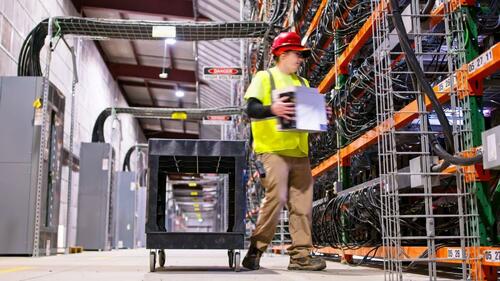Published at UtilityDive and authored by Amanda Simonian of TerraFlow Energy, a Texas-based developer of long-duration energy storage solutions.
I spent most of September on the road, from RE+ in Las Vegas to Climate Week NYC, Houston Energy and Climate Week and Data Center World Power in San Antonio. Four different audiences, four very different rooms, but one conversation that always found its way to the surface: power. Not just how much we need, but what kind. The quality, the stability and the very real stress being placed on a grid that was never built for what is coming next.
It is the problem no one planned for. As the next wave of data centers energizes, operators are discovering that the real challenge is not just finding enough megawatts. It is what happens when those megawatts do not stay still.
AI workloads do not draw power the way traditional computing does. They surge. They idle. They fluctuate thousands of times a second, driving load profiles that look less like a flat demand curve and more like an EKG. For utilities and transmission operators, that volatility is more than an inconvenience. It is a destabilizing force on local feeders and substations that were never designed to handle such rapid swings.
Industry experts have been warning about this for more than a year. Recent reliability assessments have pointed to the rise of emerging large loads such as AI campuses, crypto miners and hydrogen plants that are reshaping how the grid behaves. The North American Electric Reliability Corp. has noted similar concerns in its discussions on these new load types, including their unpredictable growth, extreme ramp rates and the coordination challenges they create for utilities and grid operators.
The grid can handle large loads. What it can’t handle, at least not yet, is a 300-MW campus that behaves like a strobe light, pulling hard one second and backing off the next. Transformers trip. Frequency control tightens. Backup generation spins when it shouldn’t. And the more facilities come online, the more that volatility compounds.
This wasn’t an unknown risk, just an underestimated one. Engineers warned of harmonic distortion and ramp-rate limits long before “AI” became a utility buzzword. But the pace of construction outstripped the pace of adaptation. What was once a handful of hyperscale sites has become a nationwide build-out measured in gigawatts, each carrying a microgrid worth of volatility.
The truth is simple: every data center is about to play a role in grid stability, whether it wants to or not. Power quality, inertia and ramp control are no longer the grid’s problems alone. They are the new operating parameters for digital infrastructure.
The thing is, that shift doesn’t have to be a burden. In fact, it is an opportunity to turn what was once a point of stress into a stabilizing resource to the grid. But meeting that challenge requires technology built for continuous cycling and endurance. Lithium-ion, optimized for short discharges and limited duty cycles, was never designed to chase a data center’s power curve all day. Flow batteries, on the other hand, can. They operate like engines with fuel tanks — steady, durable and capable of near-infinite cycling without degradation.
Long-duration flow systems can sit quietly at the DC link, absorbing or releasing power in milliseconds to smooth out spikes before they ever reach the grid. They bridge the gap between UPS and energy storage, conditioning power in real time and sustaining it for hours when needed.
That is the next evolution of resilience: not just keeping servers online, but keeping the power around them steady. It is a design choice, an engineering discipline and, increasingly, a responsibility.
The grid of the future will not be built around data centers. It will be built with them. And the ones that understand that first will define how the next decade of digital growth actually stays online.
Loading recommendations...
